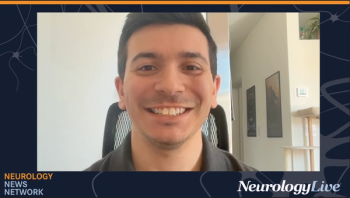
In the third episode, Salloway emphasizes the need for careful patient selection when prescribing donanemab to minimize serious risks, highlighting the value of the newly approved safer dosing regimen. Supported by Eli Lilly.

In the third episode, Salloway emphasizes the need for careful patient selection when prescribing donanemab to minimize serious risks, highlighting the value of the newly approved safer dosing regimen. Supported by Eli Lilly.

Dementia expert Stephen Salloway, MD, PhD, overviews the stepwise donanemab regimen approved by the FDA, citing how it not only reduces ARIA rates but preserves the same level of amyloid reduction as the original dosing. Supported by Eli Lilly.

Neurology News Network. for the week ending August 9, 2025. [WATCH TIME: 4 minutes]

Expert Stephen Salloway, MD, discussed findings from the TRAILBLAZER-ALZ 6 study, highlighting how a stepwise donanemab dosing regimen significantly lowered rates of ARIA in early Alzheimer disease. Supported by Eli Lilly.

The director of pediatric epilepsy at NYU Langone Medical Center shared expert insights on improving transitions from pediatric to adult epilepsy care. [WATCH TIME: 3 minutes]

The corporate vice president of medical information and research at Theranica discussed long-term findings presented at AHS 2025 covering the company’s Nerivio remote electrical neuromodulation device for patients with migraine. [WATCH TIME: 5 minutes]

Two experts from Cerevance discussed data from the company’s posters recently presented at AAIC 2025, which highlighted potential therapeutic targets for Alzheimer disease. [WATCH TIME: 5 minutes]

Panelists discuss how SCN1A genetic testing has enabled earlier diagnosis of Dravet syndrome, though some clinicians still hesitate to order tests due to discomfort with genetics, emphasizing that early genetic confirmation is crucial for avoiding contraindicated sodium channel medications, implementing appropriate treatments, and providing families with answers and community connections that improve long-term outcomes.

Panelists discuss how early recognition of Dravet syndrome's key clinical features—including prolonged seizures triggered by fever or illness in the first year of life, the importance of genetic testing for SCN1A variants, and the progressive nature of the condition that evolves from initial febrile seizures to multiple seizure types alongside developmental delays—can support timely diagnosis and improve long-term outcomes for pediatric patients.

At AAIC 2025, the head of AD, MS and Immunology Development Units at Biogen discussed ongoing research efforts targeting tau pathology in AD, specifically the company's investigational candidate BIIB080. [WATCH TIME: 6 minutes]

The neurologist at Duke Health provided insights on how chronic demyelinating inflammatory polyneuropathy treatment is evolving toward biomarker-driven, personalized approaches at the 2025 Carolina Neuromuscular Summit. [WATCH TIME: 2 minutes]

The director of the Sean M. Healey & AMG Center for ALS at Massachusetts General Hospital gives clinicians insight on the reasons to attend the 2025 Carolina Neuromuscular Summit. [WATCH TIME: 3 minutes]

The Harold I. Nemuth Chair in Neurological Disorders at Virginia Commonwealth University discussed new data supporting the potential of GLP-1 RAs as a non-surgical option for idiopathic intracranial hypertension. [WATCH TIME: 3 minutes]

The advisory board member of the Parkinson's Foundation shared personal insights on how love, present-moment awareness, and hope shaped her approach to living with the Parkinson disease. [WATCH TIME: 6 minutes]

The professor of molecular neurology at the University of Cambridge highlighted recent research on tau protein aggregation in Alzheimer disease and other related tauopathies. [WATCH TIME: 6 minutes]

Panelists discuss how treatment decisions for complex cases like the 66-year-old man with severe dyskinesia and 4 hours of daily OFF time require individualized approaches based on patient tolerance, with options including delayed-release/extended-release amantadine (starting at lower doses in older patients due to hallucination risk), extended-release carbidopa-levodopa formulations, infusion pumps for potential deep priming effects, or deep brain stimulation for patients seeking rapid improvement, emphasizing the importance of engaging patients in discussions about their patience for dose adjustments, risk tolerance for adverse effects, and desired timeline for symptom control to guide optimal treatment selection.

Panelists discuss how excessive daytime sleepiness significantly impacts patients' work productivity and quality of life, yet many patients rationalize their symptoms as normal or fail to recognize the severity of their condition, making thorough clinical questioning essential.

Panelists discuss how to differentiate true excessive daytime sleepiness from general fatigue or tiredness, emphasizing the importance of collaborative care with other specialists to address underlying mood disorders and comorbid conditions that may complicate diagnosis.

The director of neurosurgical pain division at Allegheny General Hospital highlighted the push to intervene earlier with neurosurgical treatments for chronic pain, including diabetic neuropathy. [WATCH TIME: 4 minutes]

Panelists discuss how a 66-year-old man with 8 years of Parkinson disease progression presenting with severe peak-dose dyskinesia affecting basic functions like eating and speaking, plus 4 hours of daily OFF time despite frequent dosing, represents a patient who should not have been allowed to progress to such advanced motor complications, emphasizing that the preferred approach is early intervention to treat motor fluctuations and dyskinesia as they develop rather than waiting until patients reach this severely impaired state with complex symptoms requiring more intensive management strategies.

The Emeritus Professor of Cognitive Neurology at VU University Medical Center talked about findings presented at AAIC 2025 from the phase 3 BROADWAY trial of obicetrapib in Alzheimer disease. [WATCH TIME: 3 minutes]

Neurology News Network. for the week ending August 2, 2025. [WATCH TIME: 4 minutes]

The chief development officer at Spinogenix shared initial results from the first cohort of the company’s phase 2 trial assessing SPG302 in Alzheimer disease presented at AAIC 2025. [WATCH TIME: 6 minutes]

The senior data scientist at Linus Health discussed how acoustic and speech-based metrics can be used to capture subtle cognitive signals during neuropsychological assessments. [WATCH TIME: 6 minutes]

The chief scientific officer at Neurogen Biomarking outlined a novel home-based diagnostic model that can accelerate detection of early AD through biomarker profiling. [WATCH TIME: 5 minutes]

In this final episode, the sleep experts analyze real-world prescribing data to understand how low-sodium oxybate impacts the use of traditional alerting agents in narcolepsy. [WATCH TIME: 4 minutes]

The associate professor of neurology at Icahn School of Medicine at Mount Sinai discussed the clinical and scientific advantages of blood-based biomarkers over imaging for Alzheimer disease. [WATCH TIME: 5 minutes]

At AAIC 2025, the chief medical officer at CND Life Sciences discussed recent progress in detecting neurodegenerative diseases earlier using tools like the Syn-One Test. [WATCH TIME: 3 minutes]

In episode 5, the sleep specialists examine actigraphy data from a study of TAK-861 in narcolepsy type 1 and discuss the promise of home-based sleep tracking in clinical care. [WATCH TIME: 3 minutes]

Panelists discuss how the traditional profile of older, overweight men with thick necks remains valid for OSA risk, but clinicians must also recognize that less obvious cases in younger, smaller individuals can be easily missed and require more sensitive screening approaches.